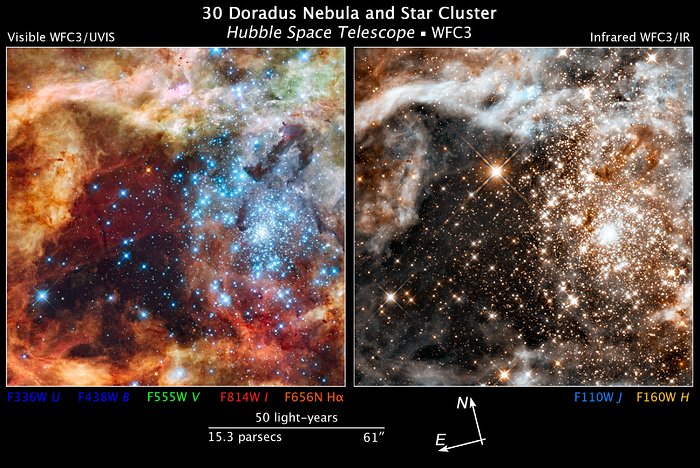Compass and scale image for 30 Doradus
This image spans about 100 light-years and is the most detailed view of the largest stellar nursery in our local galactic neighborhood. The stellar grouping, called R136, is only a few million years old and resides in the 30 Doradus Nebula, a turbulent star-birth region in the Large Magellanic Cloud (LMC), a satellite galaxy of our Milky Way. There is no known star-forming region in our galaxy as large or as prolific as 30 Doradus. Many of the diamond-like icy blue stars are among the most massive stars known. Several of them are over 100 times more massive than our Sun.
The image on the left is taken in ultraviolet, visible, and red light by Hubble's Wide Field Camera 3 and the right image is solely infrared.
Credit:NASA, ESA, and Z. Levay (STScI)
About the Image
About the Object
| Name: | 30 Doradus |
|---|---|
| Type: | Local Universe : Nebula |
| Distance: | 170000 light years |
| Category: | Nebulae |
Colours & filters
| Band | Wavelength | Telescope |
|---|---|---|
| Ultraviolet U | 336 nm |
Hubble Space Telescope
WFC3 |
| Optical B | 438 nm |
Hubble Space Telescope
WFC3 |
| Infrared J | 1.1 μm |
Hubble Space Telescope
WFC3 |
| Optical V | 555 nm |
Hubble Space Telescope
WFC3 |
| Infrared H | 1.6 μm |
Hubble Space Telescope
WFC3 |
| Optical H-alpha | 656 nm |
Hubble Space Telescope
WFC3 |
| Infrared I | 814 nm |
Hubble Space Telescope
WFC3 |
